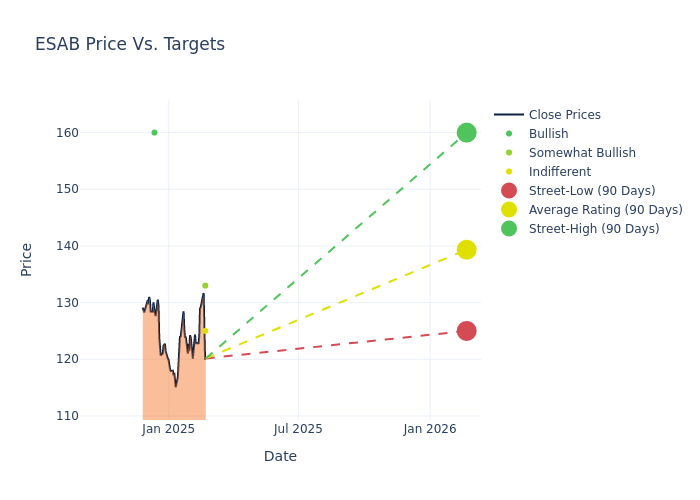In the latest quarter, 4 analysts provided ratings for ESAB ESAB, showcasing a mix of bullish and bearish perspectives.
The table below provides a snapshot of their recent ratings, showcasing how sentiments have evolved over the past 30 days and comparing them to the preceding months.
| Bullish | Somewhat Bullish | Indifferent | Somewhat Bearish | Bearish | |
|---|---|---|---|---|---|
| Total Ratings | 1 | 1 | 2 | 0 | 0 |
| Last 30D | 0 | 1 | 1 | 0 | 0 |
| 1M Ago | 0 | 0 | 1 | 0 | 0 |
| 2M Ago | 0 | 0 | 0 | 0 | 0 |
| 3M Ago | 1 | 0 | 0 | 0 | 0 |
Analysts' evaluations of 12-month price targets offer additional insights, showcasing an average target of $137.25, with a high estimate of $160.00 and a low estimate of $125.00. Marking an increase of 3.98%, the current average surpasses the previous average price target of $132.00.

Decoding Analyst Ratings: A Detailed Look
In examining recent analyst actions, we gain insights into how financial experts perceive ESAB. The following summary outlines key analysts, their recent evaluations, and adjustments to ratings and price targets.
| Analyst | Analyst Firm | Action Taken | Rating | Current Price Target | Prior Price Target |
|---|---|---|---|---|---|
| Tami Zakaria | JP Morgan | Lowers | Overweight | $133.00 | $135.00 |
| Nathan Jones | Stifel | Lowers | Hold | $125.00 | $131.00 |
| Nathan Jones | Stifel | Raises | Hold | $131.00 | $130.00 |
| Saree Boroditsky | Jefferies | Announces | Buy | $160.00 | - |
Key Insights:
- Action Taken: Responding to changing market dynamics and company performance, analysts update their recommendations. Whether they 'Maintain', 'Raise', or 'Lower' their stance, it signifies their response to recent developments related to ESAB. This offers insight into analysts' perspectives on the current state of the company.
- Rating: Unveiling insights, analysts deliver qualitative insights into stock performance, from 'Outperform' to 'Underperform'. These ratings convey expectations for the relative performance of ESAB compared to the broader market.
- Price Targets: Gaining insights, analysts provide estimates for the future value of ESAB's stock. This comparison reveals trends in analysts' expectations over time.
Considering these analyst evaluations in conjunction with other financial indicators can offer a comprehensive understanding of ESAB's market position. Stay informed and make well-informed decisions with our Ratings Table.
Stay up to date on ESAB analyst ratings.
Unveiling the Story Behind ESAB
ESAB, spun off from Colfax in 2022, is a leading manufacturer of equipment and consumables used in welding, cutting, and joining applications. Alongside competitors Lincoln Electric and ITW's Miller brand, ESAB is one of the top three players in the welding space. ESAB generated roughly $2.8 billion in revenue in 2023.
Unraveling the Financial Story of ESAB
Market Capitalization: With restricted market capitalization, the company is positioned below industry averages. This reflects a smaller scale relative to peers.
Negative Revenue Trend: Examining ESAB's financials over 3 months reveals challenges. As of 30 September, 2024, the company experienced a decline of approximately -1.14% in revenue growth, reflecting a decrease in top-line earnings. When compared to others in the Industrials sector, the company faces challenges, achieving a growth rate lower than the average among peers.
Net Margin: ESAB's net margin is below industry averages, indicating potential challenges in maintaining strong profitability. With a net margin of 10.14%, the company may face hurdles in effective cost management.
Return on Equity (ROE): The company's ROE is below industry benchmarks, signaling potential difficulties in efficiently using equity capital. With an ROE of 3.85%, the company may need to address challenges in generating satisfactory returns for shareholders.
Return on Assets (ROA): ESAB's ROA is below industry standards, pointing towards difficulties in efficiently utilizing assets. With an ROA of 1.7%, the company may encounter challenges in delivering satisfactory returns from its assets.
Debt Management: The company faces challenges in debt management with a debt-to-equity ratio higher than the industry average. With a ratio of 0.64, caution is advised due to increased financial risk.
How Are Analyst Ratings Determined?
Analysts work in banking and financial systems and typically specialize in reporting for stocks or defined sectors. Analysts may attend company conference calls and meetings, research company financial statements, and communicate with insiders to publish "analyst ratings" for stocks. Analysts typically rate each stock once per quarter.
Some analysts publish their predictions for metrics such as growth estimates, earnings, and revenue to provide additional guidance with their ratings. When using analyst ratings, it is important to keep in mind that stock and sector analysts are also human and are only offering their opinions to investors.
If you want to keep track of which analysts are outperforming others, you can view updated analyst ratings along withanalyst success scores in Benzinga Pro.
Which Stocks Are Analysts Recommending Now?
Benzinga Edge gives you instant access to all major analyst upgrades, downgrades, and price targets. Sort by accuracy, upside potential, and more. Click here to stay ahead of the market.
This article was generated by Benzinga's automated content engine and reviewed by an editor.
Edge Rankings
Price Trend
© 2025 Benzinga.com. Benzinga does not provide investment advice. All rights reserved.
date | ticker | name | Price Target | Upside/Downside | Recommendation | Firm |
|---|
Trade confidently with insights and alerts from analyst ratings, free reports and breaking news that affects the stocks you care about.